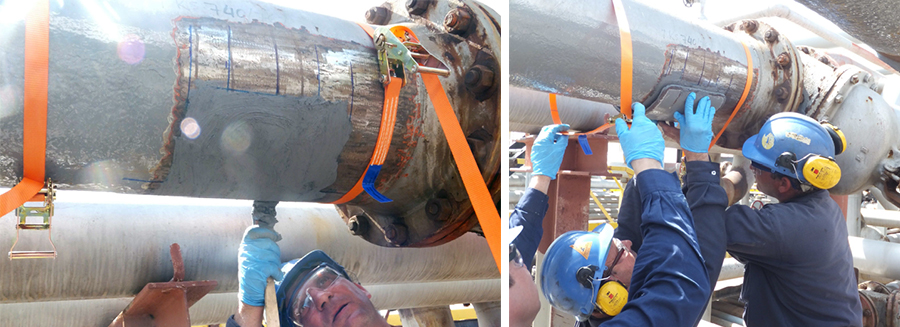The internationally accepted practice to avoid cases of Corrosion Under Insulation (CUI) is the application of a protective coating on the metal surface, before installing the thermal insulation. It is important to highlight that carbon steel pipes and equipment do not corrode externally because they are thermally insulated; rather, because its outer surface comes into contact with moisture. Hence the importance of barrier-type coatings, the correct installation and maintenance of thermal insulation systems.
Corrosion Under Insulation (CUI, Corrosion Under Isolation) is a phenomenon that normally affects carbon steel pipes and pressure equipment, as a result of the entry or condensation of water under the thermal insulation. Corrosion generated by the same cause can also be included under this condition Under Heat Insulation, (CUF, Corrosion Under Fireproofing) of pipes and pressure equipment.
The typical sources of water or humidity are external infiltrations and condensation. Not including water from outside sources from: rain, cooling tower leaks, water vapor discharges, process fluid spills, condensate fluid spray from refrigerant service equipment, fire sprinklers, flooding and washing, among others. External water enters an insulated system primarily through openings in the weather protection (figure 1). Openings or breaks in external protection systems can be the result of improper design, improper installation, mechanical abuse, or poor maintenance practices.

Atmospheric moisture condensation occurs when the metal surface temperature is less than the dew point temperature. It is impractical and costly to design vapor-tight thermal insulation systems, but proper installation of insulation systems and application of paint or barrier-based coatings minimize CUI damage (Figure 2).

Causes of Corrosion Under Insulation (CUI)
Among the main factors that cause Corrosion Under Insulation (CUI, Corrosion Under Isolation):
Contaminants in infiltrated or condensed water: They can increase the conductivity and/or corrosivity of the water and can also reduce the protection offered by the oxide layer produced by corrosion on the carbon steel surface. Contaminants can be external to the insulation materials; and contaminants contributed by the insulation materials. These are carried away by water or air and can enter the insulation system directly through cracks in the weather protection.
Chlorides and sulfates: They are the main contaminants found under the insulation. Whether of external or internal origin, they are particularly harmful because their respective metal salts are highly soluble in water, and these aqueous solutions have high electrical conductivity. In some cases, hydrolysis of metallic salts can cause localized corrosion due to low pH in the anodic areas.
Chloride is generally the main contaminant contained in insulation materials, unless the insulation product is declared “chloride-free”. They can be present in almost every component of the insulation system, including caulk and sealant. As water enters the system, contaminants are leached from the material and become concentrated as water evaporates from the carbon steel surface. If the insulation materials contain leachable acidifying compounds in the water, it lowers the pH of the water, leading to increased corrosion.
How to prevent Corrosion Under Insulation?
The following steps can be used to prevent [1]:
- Guarantee the correct design and installation of the components of the thermal insulation and fireproofing systems. Following the best practices and international standards.
- Use low chloride thermal insulation for austenitic stainless steel components.
- Use cast-in-place insulation, foamedglass or equivalent in critical areas or for austenitic stainless steel.
- Application of anticorrosive coatings to metal surfaces of lines and equipment before thermal insulation.
- Implementation of programs for inspection and prompt repair of thermal insulation and fireproofing installed in process plants.
Conclusion
The main factor of Corrosion Under Insulation (CUI) is moisture, it is produced when it is trapped between the insulating materials and the surface of an equipment or pipe. With nowhere to escape, moisture is trapped in contact with the bare metal and begins to corrode the surface. Corrosion can only be detected by removing the insulation; an expensive and time-consuming process. This type of condition is unpredictable and can cause potentially catastrophic equipment failure, it is essential that pipes and containers are inspected regularly. Thermal insulation materials should allow easy access for inspection as well as quick reset.
References
- A Strategy for Preventing Corrosion Under Insulation on Pipeline in the Petrochemical Industry. By Brian J. Fitzgerald, ExxonMobil Chemical Company and Dr. Stefan Winnik, ExxonMobil Chemical Ltd.

